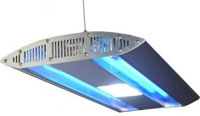Saltwater Aquarium Lighting
Fluorescent Lighting
 The fluorescent lighting method an older method of lighting however a type of bulb, compact fluorescent, a U shape bulb is good to use with fish-only aquariums. Important: Fluorescent lighting will give you very limited results with corals so if you have a reef aquarium, we strongly advise you to use metal halide lights, not fluorescent.
The fluorescent lighting method an older method of lighting however a type of bulb, compact fluorescent, a U shape bulb is good to use with fish-only aquariums. Important: Fluorescent lighting will give you very limited results with corals so if you have a reef aquarium, we strongly advise you to use metal halide lights, not fluorescent.
Below we have listed some advantages and disadvantages of using fluorescent lights on your marine aquarium for you to compare:
Advantages:
- Gives an even spread of light with even intensity throughout the length of the tank.
- Inexpensive to purchase and operate.
- Easy to house in light hoods.
- Can promote algae growth from the light spectrum released into the water ideal of you have fish that feed on the algae.
- Can combine different spectrum tubes to create full spectrum lighting great re-created a fish's natural environment and simulating natural behavior.
Disadvantages:
- Cannot be used with corals
- The lighting appears 'bland' and it lacks the rippling effect that the sun causes when it shines in the water.
- Can promote algae growth from the light spectrum released into the water unwanted of you do not have any fish to eat the algae.
- Does not bring out the true beauty in the natural colors of the fish.
- Full spectrum or specialized spectrum lighting loses it's efficacy quickly and should be replaced every 6 months to refresh the color and give off the same light intensity.
Metal-Halide Lights
The metal halide lighting method is newer technology and highly desired among saltwater enthusiasts. metal halide is a must have for reef tanks as the corals have a symbiotic relation with algae that lives with them, the metal halide lights promote the growth of this algae.
Below we have listed some advantages and disadvantages of using metal halide lights on your marine aquarium for you to compare:
Advantages:
- Stunning reflective qualities, simulates the sun shining through the water
- Brings out the best color in the fish
- Good for deep tanks as the light reaches the bottom
- Simulate natural conditions for fish and corals, they can move into the light or hide in a shadowed spot for privacy.
Disadvantages:
- Expensive and has a large power consumption.
- Short bulb life metal halide bulbs must be replaced every 8-12 months.
- Cooling fans may be re required as the lights give off lots of heat.
For the fish-only tank, fluorescent lights will do. Metal halide is required for corals an invertebrates. You can also combine the two types for a complete lighting effect simulating real sunlight. Try to combine varieties of fluorescent lights to complete the light spectrum levels for your fish. Remember, happy fish are healthy fish!

It is important not to allow water to come into contact with the lights, fish splash and your cleaning routine could splash water and this will cause electrical problems you don't want. Usually, a thin layer of glass or plastic is used as a cover, if you use one of these methods, be sure to clean it well and prevent any spots or calcium buildup because it will reduce the intensity of the lighting reaching your fish tank.
Remember that in nature, fish live at all depths therefore the lighting is not always very intense. Some fish actually appreciate more subdued lighting and feel more comfortable. If the lighting is strong, try providing spots that are sheltered form the lights, like a rocky overhang.
High intensity lighting is required if you need to bloom algae for algae eating fish to feed on. There any many other specifics that must be considered before choosing your preferred type of lighting so it is recommended to get the advice on each individual species of marine fish that you want to add to your saltwater aquarium.
For the next steps in setting up your marine aquarium, click here: Saltwater Aquarium Filtration
